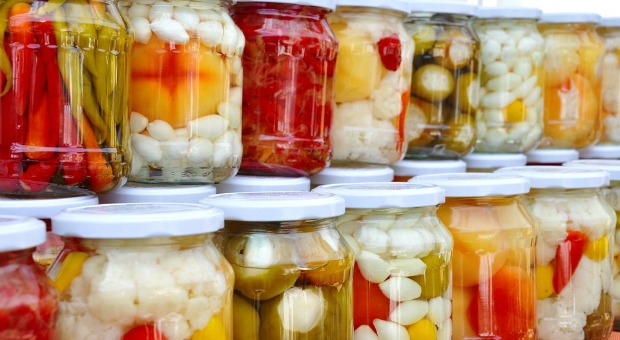You’ve worked hard in your garden and now you have a ton of beautiful vegetables ripe and ready to eat. What should you do with them, though? Preserve them, of course! There are many ways to prepare your produce so that you can store your vegetables long-term and enjoy them for months, and even years, to come!
Can Vegetables
This is probably the most common way to preserve your vegetables for long-term storage because canned veggies can be eaten up to a decade (or longer) after they’re preserved. There are a few methods that you may choose depending upon the type of vegetable that you are canning. For some vegetables, you may choose the water bath method, and for others, you’ll need to pressure can them.
The reason that canning preserves your food is because, during the process, bacteria are killed and most of the air is released out of the jar. The jar seals because air shrinks as it cools, causing the rubber around the seal to create a vacuum in the jar. Thus, air and bacteria can’t get into the jars and spoil the food.
How long you have to boil the jars in order to kill the bacteria depends upon the type of vegetable that you’re canning.
Water Bath Canning
Water bath canning is great for canning fruits, high-acid vegetables such as tomatoes, or for vegetables that are canned in a high-acid juice or sauce. We’ll get into the reason behind this when we talk about pressure canning in a minute. This manner of canning is relatively easy to do and only requires a few pieces of equipment that you likely have on hand including:
- A pot large enough to hold your jars and tall enough that you can fill it with enough water to cover your jars to the neck.
- A rack that sits on the inside bottom of the pot to keep your jars from coming into direct contact with the bottom of the pot.
- Canning jars
- Canning rings
- Canning lids with seals
- Tongs (preferably canning tongs) to remove the jars from the pot
- A spatula small enough to slide down the inside of the jar to release air pockets
You can buy a pot specifically designed for water bath canning. It comes with the rack for the bottom and the size is already adapted to hold a certain amount of jars. If you don’t have one, though, you can use a stock pot or pressure cooker pot.
Pressure Canning
This procedure requires a pressure cooker and is required for canning low-acid vegetables and meats. Since most veggies are low-acid, this is the method that you should use in order to avoid botulism. The botulinum toxin that causes botulism thrives in low-acid, low-air environments such as in canned, low-acid veggies.
Botulism affects your central nervous system and can easily kill you, especially if you’re young, old, or have a weak immune system. Even if you’re healthy as a horse, botulism will still make you extremely sick and the damage to your central nervous system can be permanent.
Some signs that your canned food contains botulinum toxin are bubbles in the jar, food or juice oozing out of the jar, a big release of air and possible spewing of juice or veggies when you open the jar, or a slimy white or cloudy discoloration in the jar. If your canned goods show any of these signs, throw them away. It’s not worth the risk.
The only equipment that you’ll need to pressure can that’s different from water bath canning is a pressure cooker. You don’t have to can vegetables separately, so get creative. You can actually can entire meals, such as vegetable or beef stew. I’ve created some pressure canning recipes in this article to get you started.
Dry Canning
This method is often used for vegetables that you’ve dehydrated in order to significantly extend shelf life. There are a couple of different methods of dry canning, but the most reliable is probably to use oxygen absorbers. Dry canning only works for dried foods, including vegetables, flour, sugar, and dried meats, pastas, and dry mixes such as cake mixes.
Dehydrating
Dehydrating your vegetables is another great way to preserve them, especially if you dry-can them after you dehydrate them. You can use a food dehydrator or oven, hang them in a cool dry place, or dry them in the sun. Which way you choose depends upon the type of vegetable and your personal preference. You can even make your own food dehydrator!
To use dehydrated food, you can either eat it as-is or rehydrate it and use it in its (almost) natural form. Dehydrating preserves most of the food’s nutrients, so it’s a good way to go and provides a delicious, nutritious food that’s lightweight and space-efficient.
Pickling
Pickling food is another way that you can preserve vegetables for long-term storage. Many people confuse pickling and fermenting but there’s definitely a difference that we’ll discuss in the next section. Pickling your vegetables simply consists of soaking them in brine, typically made of vinegar, until they’re preserved.
You’ve probably eaten pickled cucumbers, cauliflower, banana peppers, jalapenos, beets, beans, or even carrots. Just about any vegetable can be pickled, though not all taste so great when preserved this way.
There are old styles of pickling that don’t call for canning, but to ensure that all bacteria are killed, modern pickling involves cooking the pickled vegetables, usually using water bath canning in order to make them practically non-perishable as long as they’re pickled and canned properly.
Here is a nice infographic from fix.com about how to pickle anything like a pro.

Fermenting
Do you love sauerkraut and yogurt? How about vinegar (which, by the way you can make at home)? They’re all made by a process called fermentation. Fermentation is a chemical process that occurs naturally. Since we’re talking about veggies, it occurs when salt is added to a vegetable. It’s a simple process that we cover in this article.
Many people add water and a starter to hasten the process, but most vegetables will ferment on their own with just salt. This is because the bacteria needed to start the fermentation process are on the skin of all organic vegetables.
Note that I said “organic”. It’s important that you use organic vegetables when fermenting because they don’t have chemicals such as pesticides on them, and the natural bacteria haven’t been washed away.
Fermented foods are packed with enzymes, probiotics, and lactic acid. They don’t lose vital nutrients such as vitamin C during the process; in fact, some nutrients are actually enhanced by the fermentation process. The nutrients in fermented food are also more bioavailable than in the raw product. Though canned foods retain many of their nutrients, the heat kills the enzymes and probiotics that are so good for you.
In order to preserve your vegetables long-term for survival, it’s always best to use fresh, ripe produce that has no bad spots. You don’t want it to be overripe, but you don’t want it to be green either; not in most cases anyway.
How you choose to preserve your food depends on the type of food, how long you want to preserve it for, how you plan to use it, and how much space you have. Sometimes it comes down to personal preference! Remember that all of these methods can be performed without electricity should you need to do it.
We have the sun for drying, fermenting only requires salt and a cool place, and pickling and canning only require a fire. If you’ve preserved food in any of these manners and have something to add, or if you’d just like to talk about food preservation a bit more, please do so in the comments section below.
This article has been written by Theresa Crouse for Survivopedia.





































































When I was a kid, my dad would make pickled corn. Best stuff I had ever eaten. We had a 5 gallon crock, it was put in the basement for corn only. I would sneak in it every so often. lol.
You can also get a Harvest Right Freeze Dryer for your home. They are a bit pricy, but worth every penny. The veggies turn out perfectly. Watch some of the videos about the freeze dryer online.